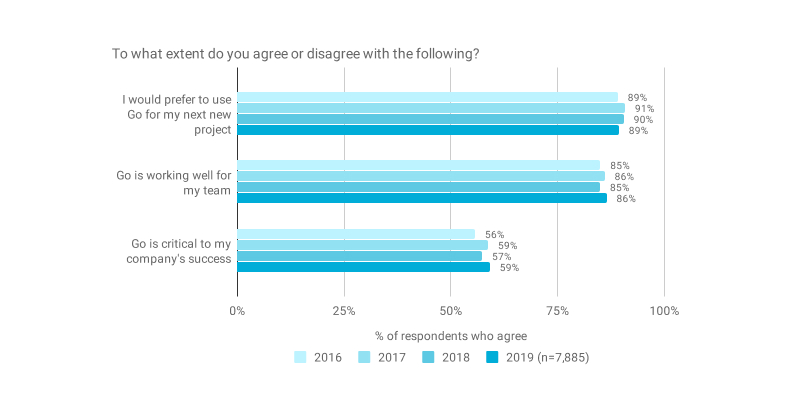We use cookies to ensure we give you the best experience on our website. By clicking Agree you accept our Privacy and Cookies Policy.
What is Golang used for? Exciting features and advantages

Bohdan Lisovskii
Author

March 3, 2024
Date

 9 minutes read
9 minutes read
Content
What is Go?
This procedural (systematic and well-structured) coding language was designed by Google’s lead developers – Rob Pike, Ken Thompson, and Robert Griesemer. They brainstormed it in 2007 but published two years later after refinement. Google has thousands of programmers who deal with large server software hosted on countless clusters. The purpose of creating Golang was to eliminate the unnecessary complexity of the software development process and address scalability issues.
How did it all start? In 2007, the iPhone was introduced. Although it wasn’t the first smartphone on the market, it caused a mobile app revolution – from just 500 apps available on App Store as it first launched in 2008, to more than 2 million now – only there. Naturally, there was also a pressing market need for a language that could support the development of more responsive and faster apps. At Google, C++ and Java dominated server programming, and neither was easy to use. At that time, neither JavaScript nor Python had strong typing. So, all the characteristics required by the Google team were not available with most programming languages. Thus, the idea of a new language appeared.
In his presentation at the Gopherpalooza Conference 2019 (one of the 27 devoted to Go held that year), Robert Griesemer mentioned the main strengths of his child – simplicity, strong typing, concurrency, garbage collection, fast compilation times, and ease of use. Let’s have a closer look at Golang’s advantages compared to other languages, the value it can create for a project, and the type of projects it is best suited for.

What are the main advantages of using Golang?
Performance and scalability
There is an upward tendency for a higher number of processor cores to enhance performance, for instance, in data centers. As applications grow, they need to process multiple sub-tasks. To maintain database connections, message queues, and caches, they require numerous microservices. Thanks to many built-in features, Golang has concurrency, which means that the app will perform multiple tasks simultaneously on one CPU. It’s what makes it well-suited for big scalable applications. Creating micro-threading apps might also be a solution, but with many programming languages, it is hard and not memory efficient. Golang has an equivalent of threads – goroutines, which are lightweight, take only 2KB of memory – and millions can be spun simultaneously. Goroutines have several other merits compared to threads. All in all, Go is a powerful tool in terms of concurrency, while the concurrency execution code is simple and beautiful.


Build your next game-changing solution with Golang
Our Senior Golang developers are ready to architect and build the robust, efficient, and scalable application you envision.
Stable and straightforward syntax, code readability
As we already mentioned, simplicity was among the reasons to create Golang. Go is based on C syntax but taken to a new level for safer memory management and prevention of memory leakage. Apparently, code complexity is often an obstacle to the smooth work of a big team. As mentioned above, it is a procedural language, so there are strict programming rules and established ways to perform a task. Another factor – the independence of code segments is important for its overall maintainability and the possibility of modifications. Packages instead of classes, no type inheritance, etc., in Golang syntax helps to achieve great clarity of the code.
Understanding the code is critical for the project’s success: you always need to know what it does precisely and estimate the time and memory it will use. Transparent syntax meets this goal.
Speed and fewer bugs
Being a compiled language, Go is faster than Python and Java, which influences the reliability and speed of services. It is converted into machine-level code and directly read by the processor.
The compiler also has such advantages as error checking, code optimization and facilitation of deployment. Cross-compiling is another excellent feature, which makes Golang apps compatible with many OS and platforms.
Golang is statistically typed and has a strict typization, it means that software engineers can be more focused on creating neat and safe code.
Popularity and availability of programming tools
According to 2020 State of Software Engineers Report by Hired – a recruiting marketplace, Go is the #1 most demanded programming language globally, based on the number of interview requests per candidate on this website. As of 2019, a decade after its introduction, 1.6 million developers (a.k.a. gophers) were estimated to be using it worldwide. 1200 companies have adopted it, among them IBM, Twitter, Apple, Dropbox, and YouTube. Also, it is an open-source language with over 2,000 contributors worldwide, who make it cleaner and more efficient. Apart from other interesting insights, the Go Developers Survey 2019 from the Go Blog with more than 10,000 respondents, indicates the overall high level of satisfaction with the language. It is also easy to learn, especially for those software engineers who have a background in C or Java development. Predictably, with further improvements, its popularity will only increase, so you can tap into a vast pool of talents.
One more reason to opt for Golang is the easy availability of development tools, such as plugins, editors, and IDEs, which can be freely downloaded from the GitHub repository.

The power of concurrency: Goroutines and channels
While many languages offer concurrency, Go’s approach is a game-changer. It was designed from the ground up to handle concurrent tasks efficiently and simply. The magic lies in two core primitives: goroutines and channels.
A goroutine is a lightweight, independently executing function. Unlike traditional OS threads, which are heavy and resource-intensive, goroutines are managed by the Go runtime and require only a few kilobytes of stack memory. This allows a Go application to spawn thousands, or even millions, of goroutines without bogging down the system.
Channels, on the other hand, provide a safe and synchronized way for goroutines to communicate. They act as pipes, allowing data to be sent and received between different concurrent processes. This model, known as Communicating Sequential Processes (CSP), is at the heart of Go’s design philosophy. It shifts the paradigm from sharing memory between threads to sharing memory by communicating, effectively eliminating common race conditions and deadlocks.
This powerful combination makes Go an ideal choice for building high-performance, scalable systems like web servers, microservices, and distributed applications.
Static typing and compilation: A recipe for performance
Go is a statically typed and compiled language. This is a crucial distinction from interpreted languages like Python or JavaScript.
- Static typing means that all variables must have a defined type at compile time. While this may seem rigid, it is a powerful tool for catching a vast number of potential bugs before the code ever runs. The Go compiler becomes a helpful assistant, guiding you toward more robust and reliable code.
- Compilation to machine code means that your source code is directly translated into executable machine code for a specific operating system and architecture. This bypasses the need for an interpreter, resulting in exceptional performance and lightning-fast execution times. The Go toolchain is also incredibly fast, allowing for rapid build cycles that don’t disrupt your workflow.
This combination of features ensures that Go applications are not only fast and performant but also highly reliable and easy to maintain over the long term.
Handling errors and memory: A refined approach
Go has a unique philosophy regarding error handling and memory management.
Instead of relying on exceptions, which can obscure the flow of a program, Go uses a clear and explicit error-handling pattern. Functions that can fail return two values: the result and an error. A developer must then explicitly check the error value (if err != nil) and decide how to handle it. This forces developers to consider potential failure points and write more resilient code. This principle of “explicit over implicit” is a core tenet of Go’s design.
When it comes to memory, Go includes a built-in garbage collector. This automatic process periodically reclaims memory that is no longer in use, freeing developers from the manual and often complex task of memory management. This significantly reduces the risk of memory leaks and makes Go code safer and simpler to write.
Beyond web development: Where Go truly shines
While Go is excellent for web development, its strengths make it a top choice for a variety of demanding applications:
- Microservices: Its lightweight nature, fast startup times, and concurrency model make it a perfect fit for building modular and scalable microservices architectures.
- Cloud computing: Many cloud-native tools, including Docker and Kubernetes, are written in Go. Its ability to produce self-contained, statically linked binaries makes it ideal for containerized environments.
- Command-Line Interface (CLI) tools: The simplicity of the language and its robust standard library make it easy to create powerful and cross-platform CLI tools.
- DevOps and infrastructure: Go is widely used for building networking tools, system daemons, and other infrastructure-level software that needs to be fast and reliable.


Partner with Golang experts
Schedule a free consultation to explore how Golang can solve your unique business challenges.
Summary: When Golang might be good for your project?
Golang allows for creating a lightweight and highly scalable apps. It makes the language perfect for resource-intense projects, where servers need to deal with a large number of requests, for instance, e-commerce websites with millions of users. If you plan considerable growth for your online business and want to maintain a great speed of server responses, Go is a wise choice.
Despite such disadvantages as no generics, which allow creating reusable code and might save time, and lower flexibility compared to dynamically typed languages, Golang is clean and efficient. It combines the best features of many modern languages. You can create transparent and lean software that runs smoothly on different networked devices, e.g., IoT, and multicore machines, and provide a great experience to a continually growing number of users.
Our team is ready to provide you with expert consultancy to match the needs of your business. Let’s implement your idea!





























































